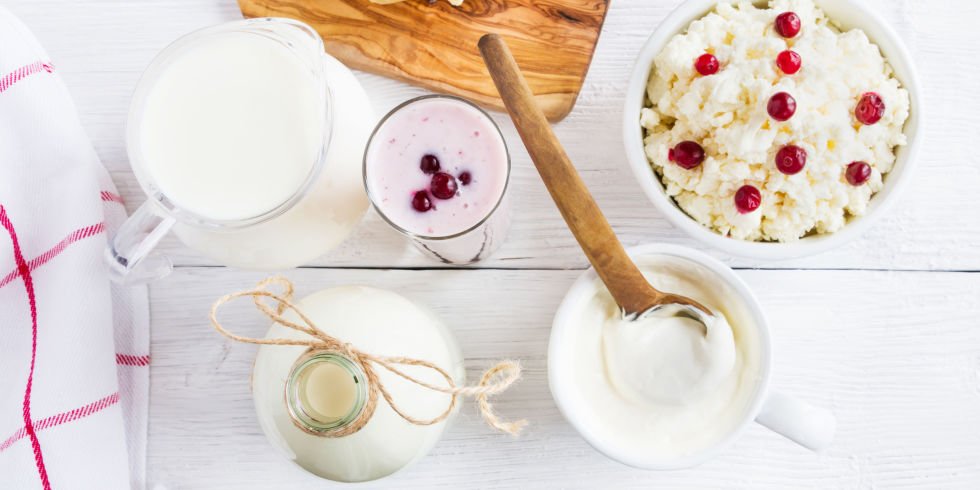

Forget chia seeds or kale: fermented foods are the health trend of the moment and the new kid on the block is kefir – a cultured, fermented milk drink.
Similar to yogurt, kefir has a slightly more tart, sour taste (some say it’s ‘fizzy’ thanks to the carbon dioxide produced during the fermentation process). Traditionally, it’s made by adding a live culture of yeast and bacteria (kefir ‘grains’) to cow’s milk and leaving it to ferment at room temperature in a glass jar or bowl for around 24 hours. Afterwards, the grains are strained and transferred to a fresh jar of milk to be used again for a new batch, and the strained kefir – full of probiotics – is ready to drink. Or avoid, if you’re feeling apprehensive…
The reason kefir is so popular is down to the ‘good bacteria’ it contains. The specific microorganisms found in the drink are said to support digestive health and prevent the growth of harmful bacteria in the intestines. Dr. Clare Morrison, GP at online doctor and pharmacy MedExpress explains:
“Our guts contain countless billions of bacteria, mainly in the small intestines and colon. They’re vital in helping digest our food properly, absorb nutrients, break down harmful chemicals, train the immune system, and prevent excessive inflammation. For optimal gut health, these bacteria need to be sufficiently diverse, and include healthy varieties such as Lactobacillus and Bifidobacterium.”
She adds:
“Fermented foods such as kefir, tempeh, miso, kimchi and sauerkraut are particularly good at promoting gut health since they’re an excellent source of Lactobacillus, which converts sugars and carbohydrate into lactic acid. This helps kill off unhealthy bacteria, preserving the food, and also gives it a tangy flavour. Studies have confirmed that these foods favourably alter the types of bacteria in the gut and countries where these foods form part of the staple diet have relatively low rates of obesity, diabetes and bowel cancer.”
“Some evidence shows that probiotics can have a positive effect on our body, helping to manage the symptoms of conditions like irritable bowel syndrome, inflammatory bowel disease, and some liver conditions. However, we don’t yet know whether taking probiotic supplements or eating probiotic-rich foods like kefir can help as the research is still currently ongoing.”
Still, most still agree that kefir is unlikely to cause any harm – and for those taking long-term antibiotics or with a weakened immune system, they could prove especially beneficial, says Dr. Morrison. “They’re helpful if you’ve taken antibiotics since they replenish healthy bacteria that will have been destroyed whilst treating the infection,” she explains.
If you’re in that camp, it’s worth speaking to a nutritionist or healthcare professional before embarking on a new routine – especially if you’re taking medication which could be affected, adds Dr. Powles.
One person firmly in favour of kefir is farmer’s wife Shann Jones. Together with her husband Rich, Shann runs the skincare company The Chuckling Goat in Ceredigion, Wales, which makes kefir products from goat’s milk. Shann says her products have helped heal stubborn eczema, chronic psoriasis, acne and rosacea and she now employs 12 staff to keep up with demand after discovering it helped heal her son’s stubborn eczema.”What motivates me is dealing with conditions that the doctors haven’t been able to help with,” she says.
“Our most popular products are our Break-Our kefir combo pack, which combines the drinking kefir along with the potent Break-Out Kefir Cleanser and Lotion. The reason goat’s milk is so effective is because [cow’s] milk contains the A1 casein, which is a serious allergen for human beings, and can trigger inflammation, autoimmune, IBS and eczema, so personally I suggest clients avoid all cow dairy.”
While plenty of experts would argue dairy forms an important part of our diet, there are still other options if you’re not sure kefir is for you. “Levels of healthy bacteria can also be boosted by taking ‘probiotic’ supplements,” says Dr. Morrison.
“These do vary, with the best ones containing large numbers of several different types of bacteria. In addition, it helps to get plenty of sleep, and avoid too much stress. Healthy gut bacteria thrive best if you eat a varied diet too – think plenty of fibre, including fruits, vegetables, salads, beans, nuts, seeds and whole grains. In my opinion, bioactive yoghurts and yoghurt drinks can be helpful, too.”
We gave it a go…
Since I’d been on antibiotics for a significant chunk of 2017, I figured kefir could be a smart move to replenish some of that much-needed ‘good bacteria’. But because it’s recommended you drink kefir first thing in the morning, I’d already hit a stumbling block. I take Levothyroxine for an underactive thyroid as soon as I wake, and it’s recommended you avoid dairy for a few hours afterwards (studies indicate it decreases the body’s ability to absorb the drug).
Instead, I opted for a mid-afternoon kefir break instead – starting with around half a glass full (most kefir devotees say you should gradually build up to a full glass). I seems that the jury is still out when it comes to timing, though, as Dr. Morrison says kefir is most beneficial when taken with meals as “it slows down the absorption of sugars, helping to prevent big spikes in blood glucose, and help optimise the absorption of minerals like calcium and magnesium.”
Figuring any time of the day is better than no kefir at all, I started with a cherry kefir from M&S and was pleasantly surprised – it tasted exactly like a regular smoothie. The bad news? Apparently it’s best to avoid these flavoured as sugary versions “negate the benefits to some extent,” according to Dr. Morrison (although I suppose it’s no surprise, really).
On day two, I try a plain version from Holland & Barrett, which was actually fine – pretty much identical to yogurt. Finally, I braved The Chuckling Goat’s version – it’s a huge shock to my taste-buds. Very sharp and sour-tasting with a definite hint of cheese, which I really struggle with. Still, I persevered (The Chuckling Goat’s kefir comes in large bottles which can last weeks) and have been drinking 170ml a day for five days now, and counting.
Is it delicious? Definitely not. Do I feel any any difference? I think it’s too soon to tell. And while I can’t help but wonder whether an easier option might be to take probiotic supplements (quicker, easier on-the-go and less faff), the science suggests it’s definitely worth a punt.
[“source=netdoctor”]






